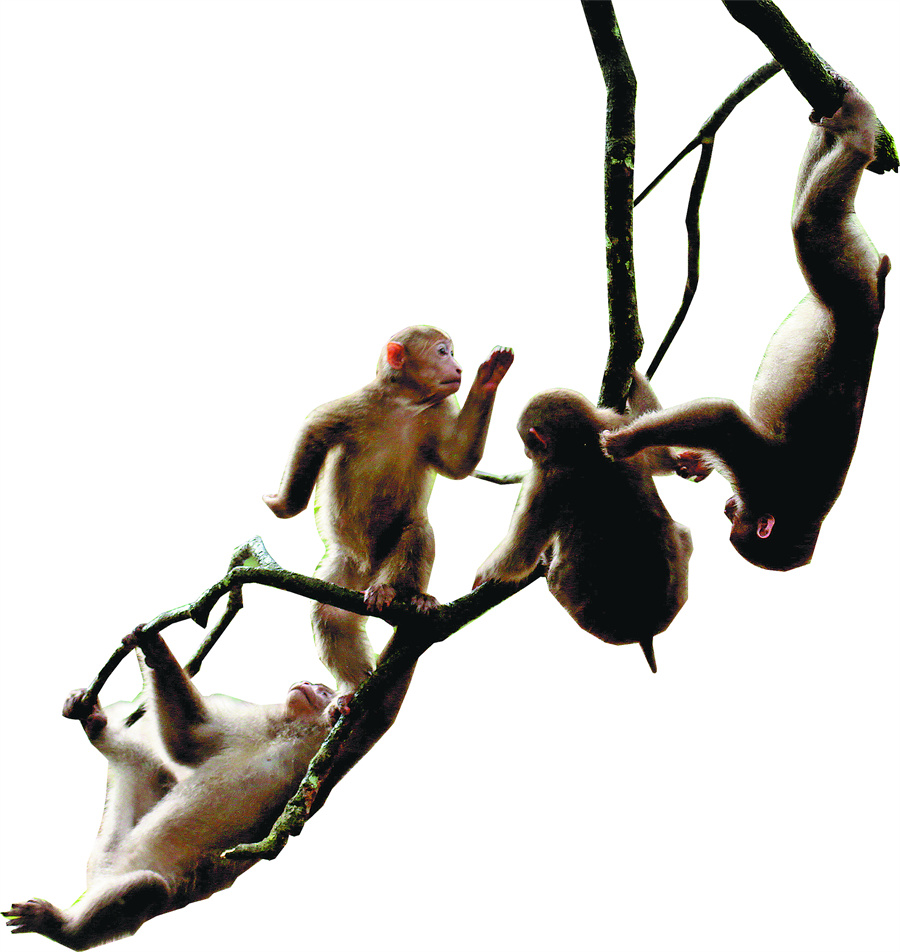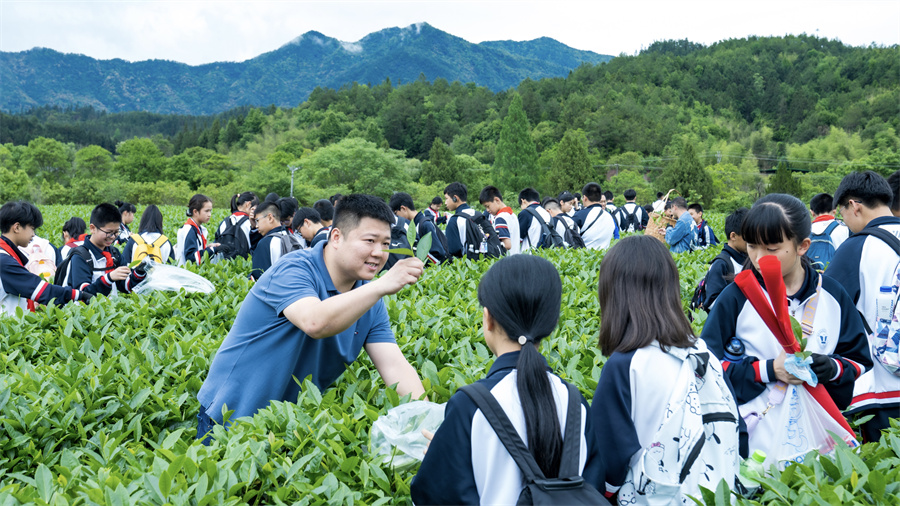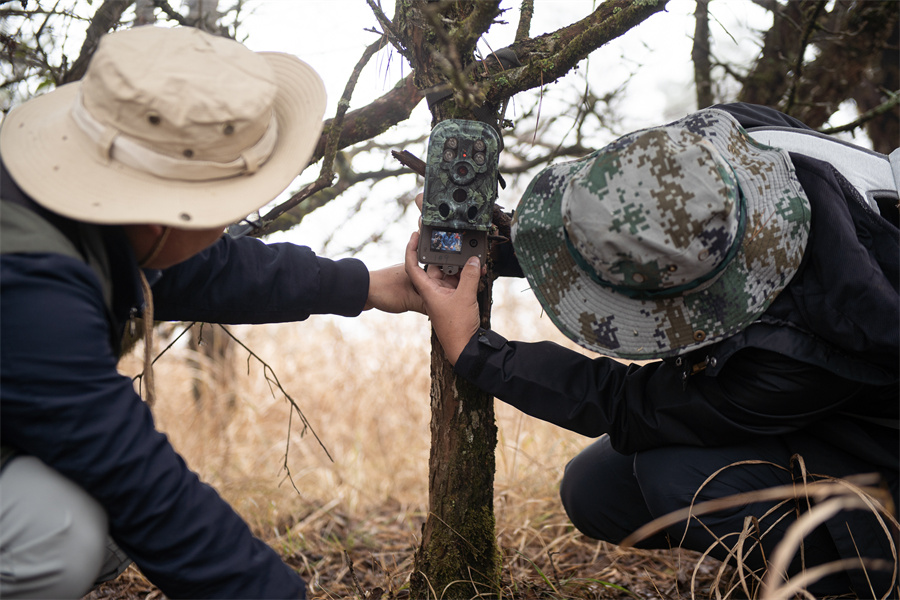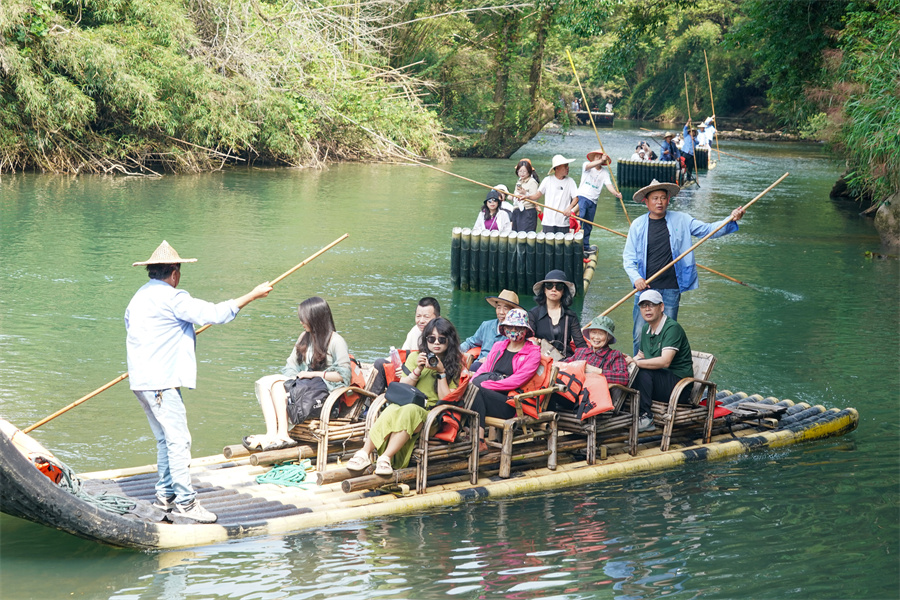Green industries in buffer zone help prevent 'isolated ecological island'

At dawn, Liu Hai'an puts on his work uniform, packs an electronic tablet, climbing ropes and food, and then heads off with his colleague to patrol Wuyishan National Park in Fujian province.
Their route covers the park's core protection zone, with elevations ranging from 400 to 2,160 meters. Liu and his partner have to scale cliffs, cross streams and pass through untouched forests, observing and recording vegetation, trees and all creatures.
"We patrol for more than 15 days each month, with each patrol lasting over three hours. When we have to go to remote areas for long patrols, it often takes six to eight hours," said the 31-year-old, who has been working at the park for seven years.
READ MORE: Gamers drive tourism boom
As full-time rangers, their daily duties include preventing the illegal expansion of tea plantations, controlling the spread of pine wilt disease, and stopping forest fires, illegal logging and poaching. If they discover any illegal activities, they have to report them and take immediate enforcement measures.
Liu recalled one risky moment when they came across a tea garden located beneath a cliff. "There was no clear path down the mountain except for a narrow staircase. It was raining and the path was slippery. We had to tie the climbing rope to a tree and slowly go down step by step," he said.
Despite their trepidation, Liu said if they hadn't overcome their fear, the rangers would have had to come back later. "We had to finish the job while we were there," he said.
Liu is one of 168 forest rangers working in Wuyishan National Park. In 2023, they conducted over 16,000 patrols, covering a distance of 40,700 kilometers, statistics showed.

Enhanced protection
Since 1999, the Wuyi Mountains have been included on both the World Cultural Heritage List and the World Natural Heritage List by the United Nations Educational, Scientific and Cultural Organization.
As one of the first five national parks established in October 2021, Wuyishan National Park spans approximately 128,000 hectares and has 210.7 square kilometers of primary forest vegetation. It is also home to more than 10,000 species of flora and fauna.
READ MORE: Riding the ‘wings of man’
Strict measures such as enhancing forest ecosystem protection and restoration, strengthening biodiversity conservation, and improving ecological protection facilities have been implemented to preserve the park's natural and cultural treasures.
Intelligent technology has also been adopted to protect Wuyishan's biodiversity and ecology. Nearly 800 infrared cameras are installed in the park to monitor surface water, wildlife, air quality, vegetation and tourist numbers, said Chen Wei, deputy head of the Wuyishan National Park Management Bureau.
A platform has also been developed to allow rangers to record patrols through photos and videos, and transmit the data to a smart management center.
The system helps ensure that management is always up to date with the latest patrol information, Chen said.
READ MORE: Ecological endeavors aim to fire economic engines across province
Through improved management and law enforcement, the park is better able to combat activities that cause ecological destruction, he said. "The mountains are greener, the waters are clearer," he boasted.
Indicators for surface water, air quality, and forest soil all meet Class I level, the highest national standard, with a forest coverage rate of 94.5 percent, Chen said.
Comprehensive protection methods not only safeguard the rich biodiversity of Wuyishan National Park, but also set a bench mark for the effective management of national parks, ensuring that nature thrives in harmony with humans, he added.

Living in harmony
With greater emphasis on protection, as well as strengthening local villagers' awareness of conservation, the ecosystem in the Wuyi Mountains is now less damaged by human activities, and is gradually recovering.
Twenty-nine new species of flora and fauna have been discovered in the national park in the past five years.
Liu has witnessed the improvements firsthand. Before the park was established, Jiuqu stream would turn muddy whenever it rained, he said. However, nowadays, unless there is a torrential downpour, the stream remains clear, and fish can be seen swimming in its water.
"As the environment has improved, the wildlife has returned as well," Liu said. "We can now easily spot flocks of Silver Pheasants during the day, but a few years ago we would be lucky to see two or three."
In 2021, Nanping city proposed the construction of a protection and development belt around the national park to, among other goals, help improve locals' livelihoods.
ALSO READ: AI-powered system assists Hebei nature reserve in protecting birds
The belt delineates a buffer zone of about 4,252 square kilometers where the preservation of natural ecosystems and biodiversity coexists with the development of green industries.
Under the innovative approach, residents can stay inside the designated development zone where protection measures are strictly enforced. The green industries permitted include ecotourism and agricultural practices such as tea growing.
The national park's favorable environment is expected to contribute to the development of the belt, said Wei Jindi, chief planner of the Nanping's bureau of natural resources and planning.
By setting red lines for ecological protection, the local government has stuck to the principle of prioritizing conservation while also being practical, he said.
"We formulated the overall plan for the protection and development belt around the park, focusing on coordination between the inner and outer circles to better preserve the authenticity and integrity of natural ecosystems, and preventing the national park from becoming an isolated ecological island," Wei said.
ALSO READ: Laying strong foundation in realms of amphibians and reptiles
By developing cultural ecotourism and other industries, the local government is seeking to promote rural revitalization and green development, he added.
The belt aims to become a model for integrated conservation and development for national parks by 2025, as well as a demonstration zone for harmonious coexistence between humans and nature by 2030, he said.

Sensitive development
Spanning 66.7 hectares, Yanzike ecological tea garden is located in park ravines, and is a core production area for Wuyi rock tea. The tea is renowned for its mineral-rich floral aroma derived from the unique soil and rocks of the region.
Yang Wenchun, one of three owners of the tea garden, said in the past cultivation had relied on pesticides and chemical fertilizers that had damaged the soil.
In 2018, the tea garden sought the help of Liao Hong, an agronomist at the Fujian Agriculture and Forestry University, to improve its cultivation methods and reduce the negative impact on the environment.
Liao, a sci-tech expert, has helped spearhead technological innovation in rural areas since 2015.
Yang said Liao suggested Yanzike use organic fertilizers and crop rotation methods to regulate and increase the organic matter in the soil. Natural pest control methods were also recommended to get rid of the company's reliance on pesticides and chemical fertilizers.
READ MORE: Tradition beats on Taiping Road
Yanzike quickly adopted Liao's suggestions and has seen positive environmental and economic results.
After the tea harvest, usually in May, Yang now plants soybeans amid the rows of tea trees, which helps replenish nitrogen levels in the soil. In winter, he plants rapeseed, which has a root system that activates phosphorus and potassium in the soil.
In addition, the ecological tea garden attracts birds and insects from the surrounding forest for natural pest control. Thirty solar-powered insect traps have been installed to ensure a double-edged approach to controlling pests.
These methods have helped improve the quality of tea, and led to better financial returns, Yang said. The tea garden can produce 75 metric tonnes of tea annually, and has increased the incomes of 56 farming households, he said.
The establishment and development of the Yanzike ecological tea garden is a prime example of how green technology is empowering the Wuyishan tea industry.
In recent years, the city has focused on the integration of tea culture, industry, and technology, while adhering to the path of green development, to create a sustainable development model tailored to local conditions.
In 2023, the total output value of the tea industry chain in Wuyishan county reached 13.5 billion yuan ($1.9 billion), with nearly half of farmers' per capita income coming from the industry, according to local statistics.

Immersive experience
Xingcun town, nestled in the heart of the Wuyi Mountains, has integrated tea culture and tourism on its path to development.
Wu Wang, mayor of the town, said that with its strong emphasis on ecological protection, Xingcun has eradicated polluting industries.
The town has 4,223 hectares of tea plantations, over 2,000 related enterprises and factories, and nearly 10,000 people engaged in tea production, processing, and marketing. The total output value of the town's tea industry reached 2.3 billion yuan last year.
One of Xingcun's special tourism offerings is the "tea journey". Visitors can participate in activities such as tea picking, processing and tasting.
They can also walk through scenic tea fields, stay in tea-themed accommodation, and enjoy meals infused with tea elements, Wu said.
The town is also moving beyond cultivation, and has started making tea-related goods, including snacks and beauty and skin care products, such as face masks, he added.
The tea industry accounts for 70 percent of the local economy, while cultural tourism makes up the remaining 30 percent. The average annual income of residents has reached 31,000 yuan thanks to these development efforts, Wu said.
In addition to the tea-themed tourism, the national park's natural beauty is also a major visitor attraction, he said.
In May this year, Wuyishan National Park's No. 1 Scenic Byway started operations. Spanning 251 kilometers, the scenic route winds through important ecosystems, stunning landscapes, natural heritage attractions, and showcases the abundant biodiversity of the national park.
As visitors drive along the road, they can explore dense forests and view crescent-shaped waterfalls, plus exotic birds and butterflies. They might also encounter a large group of national second-class protected Tibetan macaques on the road near Tongmu village.
Cai Xin, a tourist from Shanghai, has fond memories of her visits to the Wuyi Mountains in June.
Hiking through mountains and drifting on the Jiuqu stream, Cai said she was impressed by the endless greenery, and the singing of birds and buzzing of cicadas.
"It was an unforgettable experience," she said, adding she felt like she could dive into the natural beauty.
"The trees look ancient, full of history, and yet they gave me a sense of rejuvenation," she said, adding that the tour helped her forget the pressure of city life and reconnect with nature.
Deng Jiahui contributed to this story.


